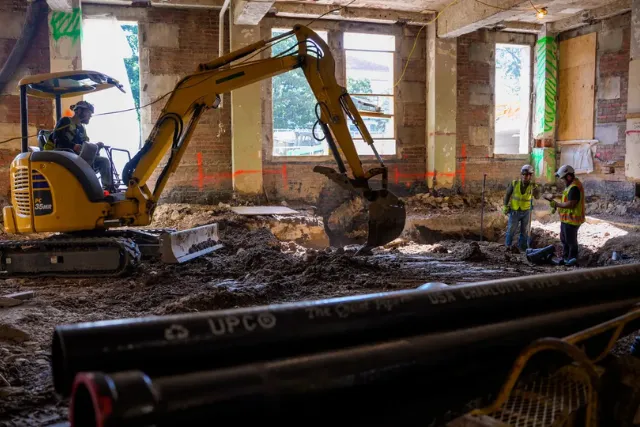
Contractors hoping for a summer rate cut to free up stuck projects will have to wait a while longer. The Federal Reserve’s decision to hold its benchmark interest rate steady in the 4.25% to 4.5% range dashed expectations for immediate relief and left builders recalibrating for a market where traditional debt remains expensive and project feasibility more fragile.

Wednesday’s decision keeps additional political and economic heat on Fed Chair Jerome Powell, as President Donald Trump continues his public campaign for looser monetary policy. While legal experts question whether a president can remove a Fed chair without clear cause, the White House has kept up pressure, highlighting the Fed’s own $2.5 billion headquarters renovation as a target. For now, however, builders counting on a cut will have to sit tight.
Elevated borrowing costs are slowing down privately funded work that relies on short-term floating debt, said Joe Biasi, head of commercial capital markets research at Newmark. “Many projects still depend on short-term floating debt,” Biasi explained, “and that structure has become harder to justify as borrowing costs have remained elevated and lenders have grown more selective.”
Still, not every market is feeling the squeeze equally. Matt Murphy, core markets leader at DPR Construction, said some segments remain resilient. “Markets that rely on more traditional financing will continue to be cautious or slower in 2026,” Murphy said. “But markets with large amounts of capital investment such as data centers and manufacturing are forecasted for continued fast-paced growth.”

That uneven playing field has forced contractors to get sharper about portfolio balance. Firms with a healthy mix of public and private work are weathering the tight capital window better than those who lean heavily on commercial lending.
“If interest rates remain unchanged going into 2026, we expect a mixed impact on our project pipeline,” said Granger Hassmann, regional president at Adolfson & Peterson. “Private sector work, especially in residential and commercial markets, will remain slow due to continued financing constraints.”
To push projects forward under tighter lending terms, contractors are doubling down on proactive project planning, value engineering, and tighter controls. Robert Brown, CEO of GCM Contracting Solutions, said the firm’s integrated design-build approach and self-performed concrete capabilities give it an edge in a more constrained environment.
“Our ability to self-perform concrete and deliver projects under a design-build model gives us an edge when speed, cost control and schedule certainty matter most,” said Brown. “Those are critical differentiators in this environment.” He added that GCM is putting more emphasis on feasibility studies and front-end procurement to lock in materials and avoid future price spikes.
With private financing tougher to secure, more contractors are leaning harder into infrastructure dollars, school bonds and other government-backed work. Peter Dyga, CEO of ABC’s Florida East Coast Chapter, said he’s seen a clear pivot in portfolios.
“There’s been a noticeable pivot toward public and institutional work,” Dyga said. “Prolonged interest rates have made private capital more cautious, while public sector projects have offered more predictable timelines and financing.”
That doesn’t mean builders are abandoning the private sector — instead, they’re shifting to segments like industrial and tech infrastructure that remain strong. “When some of our core markets are slower, others have ramped up dramatically,” said Murphy. “That allows us to shift focus to those and not pursue work outside of our normal scope.”
Part of the Fed’s reluctance to cut rates is inflation’s stubborn grip. The consumer price index rose 2.7% annually in June, still above the Fed’s 2% goal. That dynamic has forced builders to watch input costs as closely as loan rates.
“The why matters,” said Biasi. “If rates remain unchanged because of a reacceleration in inflation, that is a problem for construction activity.”

Key materials haven’t helped. A Newmark index of 21 major construction inputs climbed 2.5% in the first half of 2025 — with copper wire and cable prices alone spiking 10.3% since January, continuing last year’s surge. Those rising costs squeeze pro forma budgets and make new work harder to pencil out under higher borrowing costs.
“Construction is using short-term floating debt, so expectations of rate cuts can be helpful to getting construction going,” Biasi said. “However, higher interest rates reduce the amount of projects that can pencil.”
Projects that do proceed are often smaller or require less leverage. Or they rely on developers with cash on hand.
Some developers say they’ve already priced today’s rate reality into their pipeline. Patrick Chesser, president of the Southeast region at Ryan Cos., said they’re not waiting for the Fed to make every call.
“If the Federal Reserve holds rates steady, we do not expect a significant shift in our project pipeline,” Chesser said. He added that rate cuts could even complicate things if they push up the 10-year Treasury yield, which serves as the benchmark for long-term fixed-rate financing. “Everyone borrowing capital would prefer a lower cost, but we are in a unique environment where cutting short-term rates could actually push the 10-year Treasury higher,” he said.
Ryan Cos. updates its pro formas monthly, watches the yield curve and doesn’t bet on election-year policy swings. “We trust the Fed will continue to follow the data and remain focused on its dual mandate, rather than respond to political pressure,” Chesser said.
Looking ahead, the Fed hasn’t ruled out rate cuts later in 2025 — but as inflation proves sticky, more builders expect a cautious pace. And even if borrowing costs ease, capacity constraints remain.
“Lower interest rates may increase demand for projects,” Murphy said. “But the industry can only build as much as there is labor to do so.”
That’s why many firms are now focused on protecting backlog quality over volume and partnering more closely with clients to phase projects, streamline specs or break work into bite-sized packages that pencil under higher rates.
“There’s no question this rate environment favors disciplined builders,” Dyga said. “Firms that diversify, plan ahead and keep the client conversation going will ride it out — until the Fed finally gives them a break.”
Originally reported by Sebastian Obando in Construction Dive.